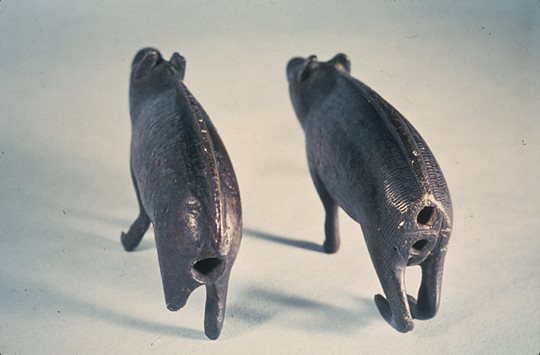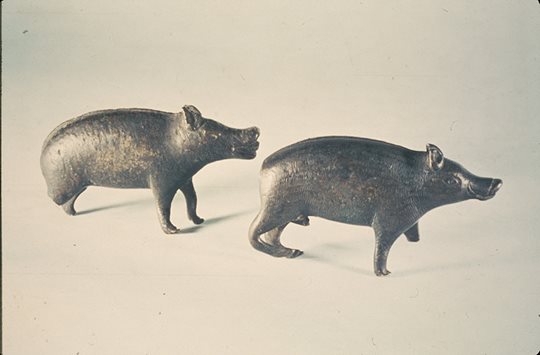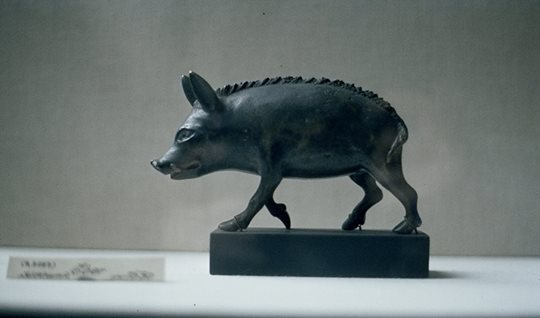Unknown
Brazen Beasts
A Pair of Bronze Boar Figurines of Uncertain Origins. A curious pair of bronze boar figurines, which were first listed in the 1861 museum catalogue of the Royal Irish Academy.
By Donna GilliganThese curious objects – a pair of bronze swine figurines - are first listed in the 1861 museum catalogue of the Royal Irish Academy compiled by William Wilde (father of Oscar Wilde). The figurines, numbered W10 & W11, are listed under the “Miscellaneous Articles” section of the catalogue and are described as follows:
W10. - No. 10, a hollow model; a good representation of the ancient Irish pig; 3 1/4.
W11. - No. 11, a hollow model of a boar, fuller, and evidently of an improved breed; 3 1/4.
Unfortunately, very little is known of the origins or discovery of these unusual pieces. It is also unknown if these two figurines were found together originally, or whether they were grouped together at a later stage due to their similarity of artefact type.

Description
Both of the figurines are hollow cast, of a similar size and style, and are made from a copper alloy material - possibly bronze. Although initially thought to represent a pair of boars, the type of swine depicted by the figurines has been the subject of some discussion. Both figurines display short legs, stocky bodies, snout-like noses, short manes and small ears, which Foster suggests points towards their possible identification as domestic pigs rather than boars. It can be suggested that W11 possibly represents a boar, and W10 most likely represents a domestic pig – specifically a sow.
W11 has a set of small tusks, and its body has been covered with an incised linear or hatching pattern to simulate the presence of hair. It displays a small hatched line crest or mane along its back. The right foreleg of this figurine is broken. Its back legs, which show cloven hooves, are bent forward, making them both longer and asymmetrical to the front pair, but also possibly suggesting that they were deliberately hooked in order for the figurine to be attached to another object or fitting in some way. While the design and symmetry of W10 appears to help it stand by itself, it seems unlikely that W11 would have been a free-standing figurine.

The W10 sow displays an open mouth, showing a protruding tongue, and has a very short crest on its back. Both of its back legs are damaged and incomplete. Both figurines display circular orifices at their posterior end, with one example on W10, and two vertically adjacent examples on W11. Possible drill grooves present around the edges of those in W11 may suggest that the orifices on that particular figurine may be a more recent alteration rather than an original part of the design, and this may suggest the use of these holes for later mounting or attachment to another fitting.
Swine Figurines and Depictions
Bronze swine figurines are a relatively uncommon artefact in Ireland and Britain, and the majority of the known bronze boar figurines from here and wider Europe are thought to originate from the Iron Age period. A lack of context or findplace information makes it difficult to assign an origin date to this particular pair. This is a common occurrence with this particular type of artefact. The large majority of the bronze boar figurines have come from unstratified contexts and uncertain provenances, which raises problems with their dating and positive identification. Foster has also noted that very few of these figurines can be dated on stylistic grounds and through comparison to similar objects on the continent.
The symbolic and social importance of the boar is a recurring feature common to several different cultures and chronological periods. Famed for its courage and aggression, the boar was viewed as a symbol of a worthy battle opponent and a military emblem, and the hunting and killing of a boar was seen as an act of valour, skill and strength. Material culture shows us that the boar was an animal of symbolic and ritual importance in late prehistoric Europe, the Greek and Roman world, and in medieval Europe. The figure of the boar can be seen on Anglo-Saxon artefacts such as the Benty Grange helmet and the Sutton Hoo dress accessories, as well as in military imagery on Celtic metalwork such as the Gundestrup Cauldron and in the mouthpieces of Celtic carnyxes.

Stories detailing the symbolic, social and mythical aspects of boars and pigs are present in Viking literature, as well as often referenced in the lore of the Irish metrical dindsenchas. In Irish mythology, pig and boar meat is presented as a high prestige food, related to rituals connected to kingship, rank and sovereignty, and playing a ritual or symbolic role in the fate of kings. The mythology of the magic pig/boar also appears in associative tales relating to Irish archaeological remains – seen in site origin legends such as those associated with the Black Pig’s Dyke. The symbol of the boar also became commonly used as a heraldic symbol during the later medieval period - one of the most noted uses being the depiction of the white boar of Richard III on his coat of arms, as well as on personal emblems such as livery or cap badges.
Bronze boar figurines are best known from the ‘Celtic’ iconography and material culture of the Iron Age period. The depiction of select animals and birds figures frequently in Celtic iconography, featuring a particular visual dominance of the creatures which would have inhabited the forests and the waters of that period. Celtic religion has been suggested to have had a nature-based character, with the artistic depiction of swans, ducks, geese, ravens, stags, rams and boars thought to have played a symbolic or totemic role in ritual and social activities.
Dating the Figurines
The initially proposed Iron Age origins of this particular pair of Irish examples have been disputed, with both Foster and Raftery instead suggesting a potential medieval date for their production. It has also been suggested that they may not actually originate from Ireland. A number of the examples of the Iron Age forms of this type of figurine are often simpler or more stylised in form, which most likely strengthens the case for a later medieval rather than a prehistoric date for the Irish figurines. However, it should still be noted that a number of more life-like and detailed examples from the Iron Age and later periods do exist, with W11 displaying a stylistic similarity to the boar depicted on the Mérida chariot model.

Personal research carried out by Eamonn Kelly, the former Keeper of Irish Antiquities at the National Museum of Ireland – Archaeology, has proposed that the figurines are late medieval in date. Kelly has suggested a sixteenth century date and a potential origin place of South Germany for the figurines, based on similarities to a small bronze pig (See Figure 5) found in the Bayerischs Nationalmuseum, Munchen.
Learn more
These objects are not on display, and are part of the Museum’s Reserve Collections. To see examples of real wild boar, visit our Mammals of the World exhibition at the National Museum of Ireland – Natural History.
References
Foster, Jennifer, 1977. Bronze Boar Figurines in Iron Age and Roman Britain British Archaeological Reports: 39.
Raftery, Barry, 1983. A Catalogue of Irish Iron Age Antiquities Marburg: Berlin.
Location:
Brazen Beasts is located at:
In Storage
Previous artefact:
Next artefact:
